Dr Vino's wine blog
wine talk that goes down easy
First Big Crush: Q&A with Eric Arnold
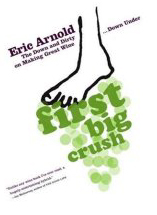 Three years ago in the New Yorker, Adam Gopnik wrote a scathing rebuke of wine writing, saying that what wine books “rarely seem to be about is drinking wine. Remarkably, nowhere in wine writing, including [Robert] Parker’s and [William] Echikson’s, would a Martian learn that the first reason people drink wine is to get drunk.” Gopnik would love Eric Arnold’s First Big Crush, which seems to try to right Gopnik’s perceived imbalance in wine writing single-handedly.
Three years ago in the New Yorker, Adam Gopnik wrote a scathing rebuke of wine writing, saying that what wine books “rarely seem to be about is drinking wine. Remarkably, nowhere in wine writing, including [Robert] Parker’s and [William] Echikson’s, would a Martian learn that the first reason people drink wine is to get drunk.” Gopnik would love Eric Arnold’s First Big Crush, which seems to try to right Gopnik’s perceived imbalance in wine writing single-handedly.
Eric, now a thirty-something News Editor at Wine Spectator magazine, tells a ribald tale of a year’s worth of winemaking (and “GD”–getting drunk) in New Zealand that would make Chaucer proud too. But in between the salty and perhaps unsavory bits is a fast-paced tale about how wine is made–mostly cleaning tanks and hoses followed by sales and marketing–and the kiwis who make it. I wrote Eric five questions I had about the book.
Practically no page goes by without some mention of genitalia, masturbation, general swearing or reference to being drunk. Why? Read more…
The Wines of France, by Jacqueline Friedrich
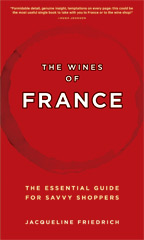 The wines of France in 360 compact pages? Heck, I’ve read a book longer than that on one region, the Loire! That was my incredulous reaction when I first spotted The Wines of France: The Essential Guide for Savvy Shoppers by Jacqueline Friedrich across the room at Barnes & Noble.
The wines of France in 360 compact pages? Heck, I’ve read a book longer than that on one region, the Loire! That was my incredulous reaction when I first spotted The Wines of France: The Essential Guide for Savvy Shoppers by Jacqueline Friedrich across the room at Barnes & Noble.
But upon closer inspection, what this svelte paperback ($13.75 on Amazon) sacrifices in depth, it makes up for in breadth. Friedrich has no shortage of tasting experience–or opinions–and wheels around her quick tour de France in what is essentially an annotated directory. She dispenses with such page-consuming graphics as maps, label images or chateau pictures. Divided into regions, each section leads with a one page overview and then heads straight into an alphabetical listing of producers and subregions. Her favorite producers receive a star, ones to watch get an up arrow, and she usually notes in the text if a producer is “eco-friendly” or not.
This is great for skimming and finding an instant nugget of information, as I could see a flummoxed sommelier or shopkeeper doing. Or you can say “hey what is this Vouvray region I’ve been reading about?” for example. Bam–a couple of ‘grafs on Vouvray and a list of her favorite producers including a paragraph on her six faves (Aubuisieres, Champalou, Chidaine, Gaudrelle, Huet, and Clos Naudin/Foreau for all you Vouvray junkies out there). This can be great for setting up an itinerary. But once there, you may want more info on the producers, which is possible in this case to get from Friedrich since she wrote that 400-page book on the Loire. So when can we expect other regional guides from Friedrich?
So just how are those opinions that she hands out with such ease? Well, they seem quite good on the whole–to wit, I had not tried the Chateau des Jacques wines from Beaujolais that she was rhapsodic about and included them in my recent Bojo tasting and I was very glad I did. However, the parsimony of the star system on display in the tiny Vouvray breaks down in areas where there are many good producers. Consider St. Emilion, where no fewer than 28 producers receive stars. This isn’t an undue amount, but it’s just that fast simplicity is lost. She goes some distance to making up for that with her “Bordeaux crib sheet,” which again narrows the field and includes many worthwhile producers. She seems to punt on the extracted/not-extracted issue, starring the likes of Bon Pasteur and Pavie, while commenting that the controversial 03 Pavie tasted “port-like.”
Ten months on from the publication date, as the 06s have been harvested and the 07s are about to be, I have only one question: what are the chances of getting a 2008 update to this handy little reference?
House of Mondavi to be released June 19
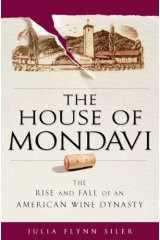 One week from today, Gotham (Penguin) will release House of Mondavi: The Rise and Fall of an American Wine Dynasty by Julia Flynn Siler.
One week from today, Gotham (Penguin) will release House of Mondavi: The Rise and Fall of an American Wine Dynasty by Julia Flynn Siler.
But if you are jonesing for a preview, you can check out Friday’s Wall Street Journal, which will run an excerpt. Maybe it will be the excellent prologue. Whatever section they run, I’m sure it will spark interest in the book. Unlike the new Diana book by Tina Brown that is excerpted in Vanity Fair this month, a broad audience is not likely to be overly familiar with the Mondavi family. The NYT today discusses whether such excerpts help books but I’d say that in this case it is a resounding yes. Hit the comments with your views.
From the advance copy floating around the Dr. Vino World Headquarters, I’d say that if you are interested in American wine, Napa Valley, business history, intergenerational family dramas, the (Italian) immigrant experience, and hubris, then this is one you want to pre-order. More later.
Dr. Vino, dead tree edition

This just in from Berkeley: my book manuscript has gotten final approval from the University of California Press!
Though based on research I originally did for my doctoral dissertation at Northwestern University, I have written the book for a broad audience. It tells the story–nay, backstory!–of wine in France and America. The title?
Wine Politics: How Governments, Environmentalists, Mobsters and Critics Influence the Wines We Drink
Does it grab you? Are you ready to pre-order from Amazon?!? Well, hold that thought: it won’t be out until Spring 08.
Until then, you can browse some of the other wine titles from the Press.
Peter Meltzer responds to your questions on wine collecting
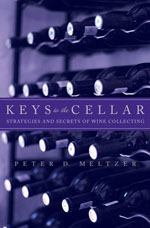 With incredible speed, Peter Meltzer, author of Keys to the Cellar: Strategies and Secrets of Wine Collecting replies to your questions. His answers follow in italics:
With incredible speed, Peter Meltzer, author of Keys to the Cellar: Strategies and Secrets of Wine Collecting replies to your questions. His answers follow in italics:
At 1:33 PM, January 29, 2007, Anonymous said…
Just this weekend I opened the first bottle of ’90 Figeac purchased at an HDH auction last year. It was flawed. It tasted more cooked than corked. What, if any, are my chances of recourse from HDH, and should I try to return the rest of the lot? I have purchased from HDH both at auction and at retail and this is the first flawed bottle from them.
Rick
Chicago
At auction, in most instances you are buying “as is,†and if the wine is off, you’re stuck. However, it sounds as if you have a pre-existing relationship with HDH, so why not contact them and dispatch an “offending†bottle of the ’90 Figeac for them to sample. Auction houses are not generally in the business of making enemies, so HDH might make an exception. In the future, however, don’t wait a year before sampling your purchases. Try a bottle right away so that you can detect potential problems in a timely fashion.
At 2:15 PM, January 29, 2007, Anonymous said…
I’m just starting to think about collecting, and I don’t have a fancy cellar or anything in place yet, just a cool (but probably not constant-temperature) basement. Should I invest in a wine refrigerator before proceeding?
It all depends on your game plan. While a temperature and humidity-controlled storage unit is always preferable, if you plan to focus on wines for immediate consumption, you can probably get by with your existing basement space. (However, if you have any intention of selling your wines at auction, a climate-controlled facility is preferable to a passive one.) If you plan to lay down fine bottlings that require extended aging, you should definitely invest in a wine refrigerator. It’s always best to choose a unit with a capacity that exceeds your present stash so that you have room to expand. If you have a modest starter collection, however, you may want to consider a small unit like the Haier (whose 93-bottle unit costs about $1,000) for your better or best bottles.
At 2:16 PM, January 29, 2007, Kasie said…
How do I know when I wine has peaked? I have a ’94 that recently went up in value, but does that mean it’s time to drink it?
Price is really not an issue here, as many wines (including oldies like 1982 classified Bordeaux, and select California bottlings from 1985 and 1987) continue to escalate in value but are not yet past peak. Vintage charts and “drink†recommendations are always helpful in determining a wine’s shelf life. Ultimately, you and your palate are the best judge. Periodically open a bottle that you think might be approaching maturity. If the color has turned to mahogany and you detect an earthy aroma and sweetish taste, it’s time to drink up.
At 2:18 PM, January 29, 2007, Anonymous said…
Maybe I’m a cynic, but it seems that people can get really competitive at auctions, and rational pricing can sometimes go by the wayside. Is there any systematic way to get real values at auction?
Yes. Probably the best recourse is to place realistic absentee or “order†bids instead of attending the auction in person. That way, you don’t risk getting swept up by auction fever. In addition, consult the Wine Spectator auction index (available online to website subscribers) which contains thousands of prices for frequently traded wines. It’s a powerful tool to cross-reference estimates against recently realized prices.
At 4:21 PM, January 29, 2007, Bruce said…
What is the best single source for tracking the progress of specific vintages of specific wines (most importantly Bordeaux) so that I know when to pull them out of the cellar? (I know, I know, depends on storage conditions, etc., but let’s assume they are “perfect”)
See above.
At 2:28 PM, January 30, 2007, Mike said…
I’m curious if you have a rule of thumb as to when a pre-auction tasting is a good value? Or perhaps how to make the most of such a tasting?
A pre-auction tasting is a wonderful opportunity to sample wines from diverse regions and vintages, many of which may be unfamiliar. It gives you a heads up on wines you may contemplate acquiring, without having to go to the expense of buying a bottle before the sale. Most auction houses list the roster of wines to be presented at the tasting (either in the catalog or online) so if you see something interesting, don’t hesitate to attend.
At 5:34 PM, January 30, 2007, Ben said…
Does the auction site matter? E.g., do you get better values at Chicago auctions vs. New York auctions?
It’s difficult to generalize, as prices will vary from lot to lot and location to location. Overall, Zachys has a large number of high winning bids – but it also has quite a number of low ones. Prices at Bonhams & Butterfields (San Francisco) can be lower than the Manhattan competition, and Hart Davis Hart may offer great value. But when HDH auctions a 20 year vertical of Château Lafleur this weekend (estimate $300,000-$400,000), don’t expect any bargains.
I have a case of 1989 Mouton in my basement (cool but passive storage conditions). How can I check the value? And what is the best way to sell it?
Thanks,
Kevin
Boston
According to the Wine Spectator second half 2006 auction index (printed bi-annually in the magazine and updated monthly for website subscribers) the average price for Mouton-Rothschild 1989 was $258 per bottle or $3,096 per case. Its high was $373 per bottle. At retail bottles range from $245-$489. If you have a friendly local wine merchant, see if he will make you an offer. Otherwise, contact one of the major commercial auction houses.
• Acker Merrall & Condit, (877) 225-3747
• Aulden Cellars-Sotheby’s (New York) , (212) 606-7050
• Bonhams & Butterfields, (415) 861-7500, ext. 307
• Edward Roberts International, (847) 295-8696
• Hart Davis Hart, (312) 482-9996
• Morrell & Co., (212) 307-4200
• NYWinesChristie’s (New York), (212) 463-8600
• Zachys (New York), (914) 448-3026
• Winebid.com
At 11:50 AM, January 31, 2007, Schliecker said…
I just bought a house and have a basement where the temp is between 60F and 65F with humitity between 30%-45% depending on the day. I have some wines I want to keep cellared for a while (not anything like an ‘82 Lafite mind you). What are your thoughts on those conditions. Good enough or would you go for a Vinotemp or something like it.
Thanks – Dave S. – Brooklyn, NY
These conditions are acceptable for short-term storage of good wines. However, have you any idea what the temperature rises to in the summer? The humidity level is on the low side.
(See second answer above for more details.)
 tags: wine | wine collecting | peter meltzer
tags: wine | wine collecting | peter meltzer
Here’s to you Ms. Robinson!
In the NYT today, Eric Asimov interviews HRH Jancis Robinson, MW, OBE aka Jancis. Perhaps the HMS Indefatigable would be a better name given the amazing number of wine projects she has from the new Oxford Companion to Wine to her FT column, to her web site.
In her most recent column, she brings up an excellent point: mid-priced wines are the hardest to sell and offer the best value. Cut to the tape:
Very, very roughly the price bracket I would argue represents the best value today is about £8-£15, or $15-$30, a bottle. Into this bracket fall typically the finest wines produced by the least celebrated producers. They lack the reputation that allows them to ask for higher prices but the price reflects distinctly superior grapes, often grown at deliberately restricted yields in vineyards that have recently been planted or upgraded, using very similar techniques to those used for far more expensive wines.
I would agree that it is a sweet spot. But it’s sort of a puzzle why this is overlooked. I guess it is like mid-grade gasoline–either you want the cheap stuff or premium.
While wines below this range offer good value, it can be frustratingly hit or miss. Moving up a notch does offer more consistency. But it also cranks up your tab if you like popping a cork every evening. Consider it sage advice for the weekend from Jancis.
Related: “The Oxford Companion to Wine, third edition” [Dr. V]
Tasting Pleasures, confessions of a wine lover by Jancis Robinson.
 tags: wine | wine values | jancis robinson
tags: wine | wine values | jancis robinson
Do try to keep up
Do you know it is easy to have Dr. Vino served up fresh?
Dine-in: bookmark this page and check back often!
Delivery: sign up to read the “feed” from the site as it rolls out. Bloglines is the most popular feed reader for subscribers, but Netvibes, My Yahoo!, and Firefox live bookmarks are also well used. Mmm…Feed…Delivery…
Mail: If you are mysteriously hooked to this web site, you can have every posting automatically sent on your Outlook or crackberry via Squeet, a service that sends site feed via email. If that is too much “pinging” in your inbox, sign up at DrVino.com for vinogram, the free monthly email of site highlights–now with bonus tracks!
Any which way, thanks for your support and comments!
Deathwatch: Rose City Wine Bar, PDX
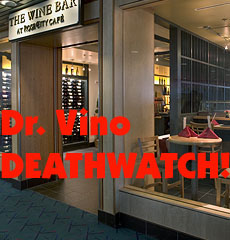
Victim: Rose City Wine Bar, Portland airport (PDX)
DOB: January 2005
Parents: Hilton Restaurant Group
Symptoms: Small, handsome wine bar with worthwhile local wines by the bottle and by the glass. Has small plate food; is a part of the casual Rose City Cafe next door. Since August it is on the wrong side of the law–the TSA that is. Dealt potentially fatal blow by the location just outside security. With longer lines and a liquid ban, few are likely to linger or buy vino to go.
Diagnosis: Deathwatch.
Deathwatch hat tip: eater
 tags: wine | wine bars | airports | air travel | PDX
tags: wine | wine bars | airports | air travel | PDX



